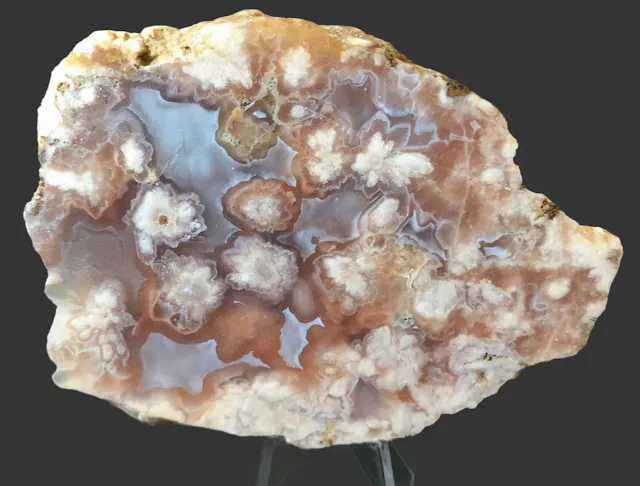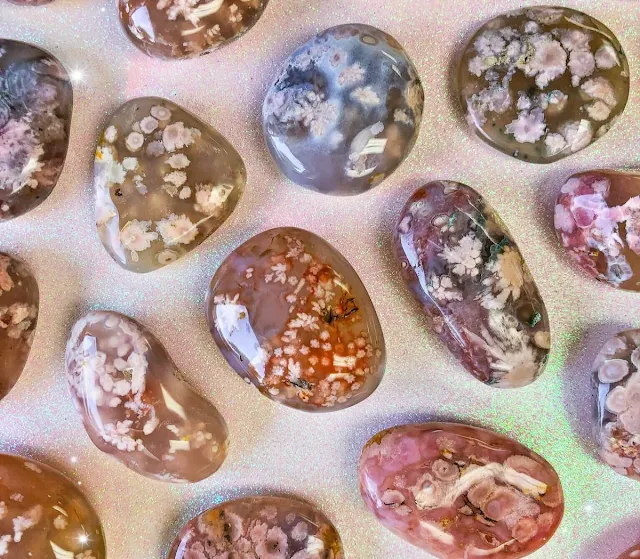What is Flower Agate
Flower Agate, a trade name for a distinct chalcedony variety, exhibits a translucent, cryptocrystalline structure with intricate floral or dendritic patterns formed by manganese-oxide or iron-oxide inclusions. These patterns, resembling blooming flowers, distinguish the stone.
The translucent base, typically in pink, peach, or white hues, scatters light due to its microcrystalline composition, producing a soft, vitreous luster and ethereal glow. Discovered in Madagascar in 2018, Flower Agate has gained prominence as a sought-after gemstone and mineral specimen due to its unique aesthetic.
 |
Natural rough and polished Flower Agate specimens with floral plumes. |
Mineralogical Composition
Flower Agate is primarily composed of cryptocrystalline silica (SiO₂). The distinctive floral patterns are created by manganese-oxide or iron-oxide dendrites and spot-like inclusions that form along microscopic fractures or growth zones. Trace elements, such as iron or manganese, contribute to its color variations, ranging from milky white to pink, peach, or rare green hues.
Geological Formation
Flower Agate forms in gas vesicles within volcanic basalt, where silica-rich hydrothermal fluids slowly infiltrate. Over millions of years, these fluids precipitate layers of chalcedony, trapping oxide impurities that develop into dendritic, floral patterns. This process, likely occurring during late Cenozoic volcanism in Madagascar (circa 2–10 Ma), requires slow cooling and silica saturation to produce the stone’s characteristic botryoidal masses.
 |
Flower Agate slab with floral chalcedony patterns, Madagascar. |
Physical & Optical Properties
- Composition: Chalcedony (Microcrystalline quartz (SiO₂))
- Hardness: 7 on the Mohs scale, ensuring durability for lapidary use.
- Lustre: Vitreous (glassy) when polished.
- Appearance: Translucent with intricate floral or dendritic inclusions.
- Color: Predominantly pink, peach, or white, with occasional gray, brown, red, or green hues. Rare black or orange variants may be dyed or treated.
Occurrence & Localities
Flower Agate is primarily sourced from central Madagascar, with the Ambatofinandrahana region being the principal locality. It is extracted from volcanic rock formations and alluvial deposits using artisanal mining methods in areas including Ambatofinandrahana, Antsirabe, Sakaraha, Ampanihy, and Ambositra. Madagascar remains the dominant source, with all commercial Flower Agate originating from this region.
Secondary, less significant deposits have been identified in Brazil, Mexico, Uruguay, and the United States, though these lack the characteristic floral patterns. Small-scale occurrences are also reported in India. Discovered in 2018, Flower Agate is a relatively new gemstone, contributing to its emerging status among agate varieties.
 |
Flower Agate gems with unique floral inclusions. |
Gemological & Trade Significance
Since its introduction to the mineral market in 2018, Flower Agate has gained popularity in lapidary applications, particularly for cabochons, beads, and freeform carvings. Its appeal lies in its high translucency and distinctive internal floral patterns, which contribute to moderate market prices ranging from USD 10–30 per carat, depending on quality and pattern clarity.
 |
| Tumbled Flower Agate gems. |
While frequently promoted in metaphysical markets for attributes such as emotional healing, inner growth, and mental calm. From a gemological standpoint, Flower Agate is valued for its aesthetic properties and unique geological genesis rather than any functional attributes.
Summary
Flower Agate stands out as a remarkable gemstone, distinguished by its intricate floral patterns formed through volcanic hydrothermal activity. Since its discovery, its striking beauty and unique aesthetic qualities have made it a prized specimen in the gem trade and a favorite among collectors.
Read also:
Types of Agate With Photos
Iris Agate: Rainbow Agate
What is Grape Agate


%20(1).webp)





